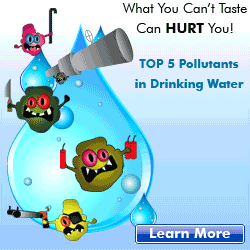
The microbiological quality of drinking water is a concern to consumers, water suppliers, regulators and public health authorities alike. The potential of drinking water to transport microbial pathogens to great numbers of people, causing subsequent illness, is well documented in countries at all levels of economic development. The outbreak of cryptosporidiosis in 1993 in Milwaukee, Wisconsin, in the United States provides a good example.
It was estimated that about 400,000 individuals suffered from gastrointestinal symptoms due, in a large proportion of cases, to Cryptosporidium, a protozoan parasite (MacKenzie et al., 1994), although subsequent reports suggest that this may be a significant overestimation (Hunter and Syed, 2001). More recent outbreaks have involved E. coli O157:H7, the most serious of which occurred in Walkerton, Ontario Canada in the spring of 2000 and resulted in six deaths and over 2,300 cases (Bruce-Grey-Owen Sound Health Unit, 2000).
The number of outbreaks that have been reported throughout the world demonstrates that transmission of pathogens by drinking water remains a significant cause of illness. However, estimates of illness based solely on detected outbreaks is likely to underestimate the problem. A significant proportion of waterborne illnesses is likely to go undetected by the communicable disease surveillance and reporting systems. The symptoms of gastrointestinal illness (nausea, diarrhoea, vomiting, abdominal pain) are usually mild and generally only last a few days to a week, and only a small percentage of those affected will see a doctor.
Several researchers have attempted to estimate the total burden of waterborne disease worldwide. Huttly (1990) reported a total number of 1.4 billion annual episodes of diarrhoea in children under five years of age, with an estimated 4.9 million children dying as a result (although these were due to all causes of diarrhoea and not just water-related cases). While Prüss et al.,(2002) estimated that water, sanitation and hygiene was responsible for 4.0% of all deaths and 5.7% of the total disease burden occurring worldwide (accounting for diarrhoeal diseases, schistosomiasis, trachoma, ascariasis, trichuriasis and hookworm disease).
Clearly, in countries where a large part of the population does not have access to safe drinking water, a substantial number of these infections will be waterborne, indeed, Hunter (1997) estimated that waterborne disease might account for one-third of the intestinal infections world-wide. The basis of ensuring water safety has five key components:
- Water quality targets based on public health protection and disease prevention.
- System assessment to determine whether the water supply chain (up to the point of consumption) as a whole can deliver water of a quality that meets the defined targets.
- Monitoring the steps in the supply chain that are of particular importance in securing safe drinking water.
- Management plans describing actions to be undertaken from normal conditions to extreme events.
Systematic independent surveillance that verifies that the above are operating properly. The management plans developed by water suppliers can be best termed a Water Safety Plan (WSP).
The control of the microbiological and chemical quality of drinking water requires the development of WSPs which, when implemented, provide the basis for process control to ensure pathogen and chemical loads are acceptable. Implicit within this process is that a tolerable disease burden has been identified at national and local levels and that water quality targets have been established for each type of technology. Waterborne disease is not restricted to developing countries. Morris and Levine (1995) attempted to estimate the annual waterborne disease burden in the United States of America and indicated that 560,000 people may suffer from a moderate to severe waterborne infection and that 7.1 million suffer from a mild to moderate waterborne infection each year.

All waterborne infections may lead to an estimated 1,200 deaths a year. Even if these rough figures are overestimated, both the health and economic burden are considerable even for an industrialised society (Payment, 1997). The diseases most frequently associated with water are enteric infections (such as infectious diarrhoea) that are also often associated with food (Mead et al., 1999). In many cases, the disease is relatively mild and self-limiting. However, a proportion of the infected population will suffer more severe outcomes, especially when the health care system is lacking.
Several waterborne pathogens, such as Vibrio cholera, hepatitis E virus and Escherichia coli O157:H7, have high mortality rates (Hunter, 1997). In recent cholera outbreaks, for example, the fatality rate was generally 1-3% but could be as high as 8-22%. Hepatitis E virus infections may lead to fulminant fatal hepatitis in 1-2% of cases, with pregnant women being especially at risk of more severe disease. Waterborne infections with E. coli O157:H7 are associated with haemorrhagic colitis and haemolytic uremic syndrome, both serious illnesses, with the latter occurring particularly in children. The fatality rate in waterborne outbreaks is 0.3-1.6% (Hunter, 1997; Bruce-Grey-Owen Sound Health Unit, 2000).
In the 1990s, evidence that microbial infections are associated with chronic disease started to accumulate. Several waterborne pathogens have been associated with serious sequellae (i.e. severe illness or chronic or recurrent disease that appears long after the initial exposure to contaminated water). Examples of sequellae that could potentially be associated with the acute waterborne disease include:
- Diabetes, which has been linked to Coxsackie B4 virus (Roivainen et al., 2000; Horwitz et al., 1998).
- Myocarditis, which has been linked to echovirus (Ferreira Jr. et al., 1995; Shanmugam et al., 1986).
- Guillian-Barré syndrome associated with Campylobacter spp. (Prendergast and Moran, 2000)
- Gastric cancer, which has been linked to Helicobacter sp. (Uemura et al., 2001).
- Reactive arthritis, which has been linked to Klebsiella sp. (Ebringer and Wilson, 2000).
With the exception of Klebsiella, the association of these microbes with acute waterborne disease has been well established. More remote connections between waterborne microbes and chronic disease has not been fully established, but is highly suspected (Hunter, 1997).



